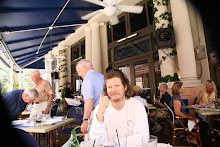Brain Constipation. . .
I'm not feeling particularly creative these days as indicated by the fact I've been sitting here for longer than I'd rather admit trying to think of something to write or some ding-dong liberal politician to viciously attack, yet I am flat, empty, void.
My creative energy has been pleasantly directed elsewhere in recent days, so today in lieu of a vulgar diatribe against an unjust world, I'll talk about the principles of photography.
Photography, quite literally, means "light-writing" and to write properly with light we must understand that a camera controls light by two functions, exposure and aperture.
Exposure is the length of time the film, or in the case of modern digital cameras is concerned, the CCD plate is exposed to a light source. Exposures can be as long as many hours or thousandths of a second depending on lighting conditions, film speed (aka ISO) or desired effect like producing the illusion of captured motion on a print.
Aperture is the size of the "opening" inside the lens that the light travels through and is important to understand because this is what gives a photo it's depth of field or clear focus from front to back or even lack thereof, if desired.
The use of these two principles together and understanding the impact one has on the other is important in creating beautiful, properly exposed and striking photographs that capture the eye and clearly tell the intended story.
Today we will focus (ha!) on aperture.
Aperture, in lens mechanics, is a leafed-diaphragm inside of the lens and operates similarly to the iris of the eye by controlling to diameter of the lens opening. Aperture stop is indicated by f-numbers (i.e. f/4, f.5.6, f/6.3, f/7.1, f/8.0, f/16, f/22) and differs from lens to lens. Aperture stop values are inversely proportional to the lens opening, meaning that f/4.0 is a large opening and f/16 is narrow. "Fast lenses" are lenses that have large maximum aperture values, some as high as f/1.0 meaning that these lens can shoot in very low light conditions without light augmentation, such as a flash.
The use of aperture is related to exposure for the obvious reason that a larger aperture (smaller f-number) will require less exposure time than a smaller aperture (larger f-number) to have proper exposure. An increase of 1.41 in aperture stop usually increases exposure time by two times as a general rule. The mathematics is a bit more complicated than that, but for simplification we'll leave it as above.
Let's look at some examples of aperture usage and it's effect on the finished photograph.
Here is an example of a large aperture opening, f/5.0. The shallow depth of field can be seen by the very few in-focus keys of the keyboard. This effect is useful when your background is filled with distrating objects that would take away from the photograph or in the case of this picture, I wanted the eyes of the viewer to be taken to that exact spot in the photo.
Here is another example of large aperture. In this case, I used f/4.0 because as you can see in the background there are many distracting elements that could potentially take away from the power of the photograph.
Now let's take a look at examples of small aperature.
Here is a nice photograph of a rainbow using f/13. As you can see, the barbed-wire fence in the foreground is clearly in focus as well as the rainbow, which was the focal point.
In this photo below of the post-tension reinforcement of a concrete slab I used f/16 for nice depth of field to highlight the maze-like structure of the moment. I think I've lost some clarity in the resizing of the photograph due to compression, but the wall forms of the elevator/stairwells are in focus as well as the steel directly in front of the camera.
As you can see, photography is a science as well as an art and the only way to understand both is to keep on clicking!!
In our next installment, we will talk about exposure times and how to use them effectively with aperture to create beautiful photographs. Until then. . .




